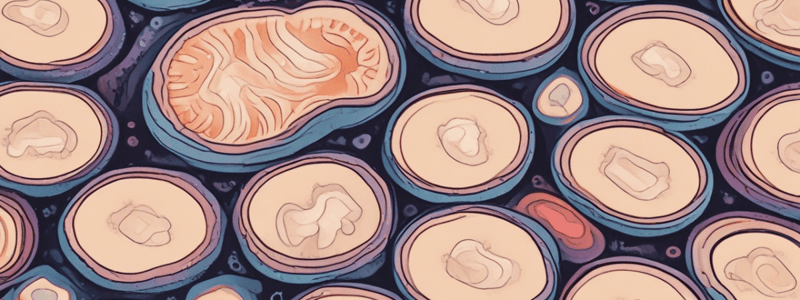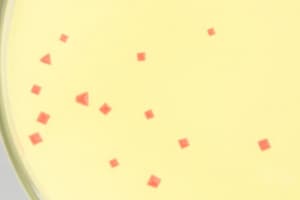Podcast
Questions and Answers
What is produced alongside indole during the hydrolysis of tryptophan?
What is produced alongside indole during the hydrolysis of tryptophan?
- Lactate
- Pyruvic acid (correct)
- Acetyl-CoA
- Urea
In the tryptophan hydrolysis test, what indicates a positive reaction in the presence of indole?
In the tryptophan hydrolysis test, what indicates a positive reaction in the presence of indole?
- Formation of bubbles
- Yellow color change
- Red compound formation (correct)
- No color change
What is the role of tryptophanase in the biochemical process described?
What is the role of tryptophanase in the biochemical process described?
- It facilitates ammonia absorption
- It degrades indole
- It hydrolyzes tryptophan (correct)
- It synthesizes pyruvic acid
Which type of reaction does tryptophan hydrolysis involve?
Which type of reaction does tryptophan hydrolysis involve?
What is the purpose of using Kovac’s reagent in the tryptophan hydrolysis test?
What is the purpose of using Kovac’s reagent in the tryptophan hydrolysis test?
How is the tryptophan hydrolysis test helpful in differentiating between bacteria?
How is the tryptophan hydrolysis test helpful in differentiating between bacteria?
Which organism shows pink growth on MacConkey agar?
Which organism shows pink growth on MacConkey agar?
What color would E.coli exhibit on Eosin Methylene-Blue agar?
What color would E.coli exhibit on Eosin Methylene-Blue agar?
Which of the following organisms is identified as a lactose non-fermenter on MacConkey agar?
Which of the following organisms is identified as a lactose non-fermenter on MacConkey agar?
Which organism would not grow on Eosin Methylene-Blue agar?
Which organism would not grow on Eosin Methylene-Blue agar?
The acidic byproduct produced by lactose fermentation on Eosin Methylene-Blue agar leads to what effect?
The acidic byproduct produced by lactose fermentation on Eosin Methylene-Blue agar leads to what effect?
Which organism is classified as a Gram negative non-lactose fermenter and produces colorless growth on both agars?
Which organism is classified as a Gram negative non-lactose fermenter and produces colorless growth on both agars?
What is the main selective property of Eosin and Methylene Blue in Eosin Methylene-Blue agar?
What is the main selective property of Eosin and Methylene Blue in Eosin Methylene-Blue agar?
What is the observation for E.faecalis on MacConkey agar?
What is the observation for E.faecalis on MacConkey agar?
Which bacterium tested positive for urease production in the experiment?
Which bacterium tested positive for urease production in the experiment?
What color indicates a positive test result in the urease hydrolysis test?
What color indicates a positive test result in the urease hydrolysis test?
What is the significance of a medium remaining orange after incubation?
What is the significance of a medium remaining orange after incubation?
What is the expected appearance of Urea broth inoculated with Staphylococcus epidermidis after 5 days?
What is the expected appearance of Urea broth inoculated with Staphylococcus epidermidis after 5 days?
Which of the following bacteria is associated with urinary tract infections (UTIs) in relation to urease production?
Which of the following bacteria is associated with urinary tract infections (UTIs) in relation to urease production?
What is the primary role of cytochrome c oxidase in aerobic respiration?
What is the primary role of cytochrome c oxidase in aerobic respiration?
What byproduct of urea hydrolysis leads to an increase in pH and a color change in the broth?
What byproduct of urea hydrolysis leads to an increase in pH and a color change in the broth?
What indicates a positive oxidase test when using the oxidase reagent?
What indicates a positive oxidase test when using the oxidase reagent?
After 5 days of incubation, what is the result for Pseudomonas aeruginosa in the urease hydrolysis test?
After 5 days of incubation, what is the result for Pseudomonas aeruginosa in the urease hydrolysis test?
What is the primary purpose of the phenylalanine deaminase test?
What is the primary purpose of the phenylalanine deaminase test?
Which bacterium is most likely to test positive for oxidase production?
Which bacterium is most likely to test positive for oxidase production?
During the oxidase test, how should the bacterium be cultured before adding the oxidase reagent?
During the oxidase test, how should the bacterium be cultured before adding the oxidase reagent?
What is the appearance of the oxidase reagent prior to testing?
What is the appearance of the oxidase reagent prior to testing?
If a microbe does not produce oxidase, what color will the oxidase reagent remain?
If a microbe does not produce oxidase, what color will the oxidase reagent remain?
What is the final electron acceptor in the process facilitated by cytochrome c oxidase?
What is the final electron acceptor in the process facilitated by cytochrome c oxidase?
What result would you expect from Staphylococcus epidermidis when performing an oxidase test?
What result would you expect from Staphylococcus epidermidis when performing an oxidase test?
Which bacterium is not capable of producing indole as indicated by the absence of a red ring upon adding Kovac's reagent?
Which bacterium is not capable of producing indole as indicated by the absence of a red ring upon adding Kovac's reagent?
What is the significance of a red ring forming at the top of the broth after adding Kovac's reagent?
What is the significance of a red ring forming at the top of the broth after adding Kovac's reagent?
Which of the following statements is true regarding the bacteria tested for indole production?
Which of the following statements is true regarding the bacteria tested for indole production?
What does the reaction of ferric chloride with phenylpyruvic acid produce?
What does the reaction of ferric chloride with phenylpyruvic acid produce?
Which bacterium is universally positive for phenylalanine deaminase among the options given?
Which bacterium is universally positive for phenylalanine deaminase among the options given?
How many bacteria in the experiment produced a negative result for tryptophan hydrolysis?
How many bacteria in the experiment produced a negative result for tryptophan hydrolysis?
What is the incubation temperature used for tryptophan hydrolysis test?
What is the incubation temperature used for tryptophan hydrolysis test?
Which amino acid is critical in the tryptophan hydrolysis process?
Which amino acid is critical in the tryptophan hydrolysis process?
Study Notes
MacConkey Agar Observations
- Used to differentiate between Gram-negative bacteria based on lactose fermentation.
- Escherichia coli (E. coli): Pink growth indicates lactose fermenter.
- Proteus vulgaris (P. vulgaris): Colorless growth shows it is a non-lactose fermenter.
- Pseudomonas aeruginosa (P. aeruginosa): Also colorless growth, confirming non-lactose fermentation.
- Staphylococcus epidermidis (S. epidermidis): No growth indicates it is a Gram-positive organism.
- Enterococcus faecalis (E. faecalis): No growth confirms it is a Gram-positive organism.
Eosin Methylene Blue Agar Characteristics
- Selectively inhibits Gram-positive organisms using Eosin and Methylene Blue dyes.
- Lactose fermentation leads to acid production, lowering pH and precipitating dyes.
- Lactose positive colonies appear metallic green.
Eosin-Methylene Blue Agar Results
- E. coli: Exhibits a metallic green growth, indicating lactose fermentation.
- P. vulgaris: Shows colorless growth, confirming non-lactose fermentation.
- P. aeruginosa: Also colorless growth, indicating it is a non-lactose fermenter.
- S. epidermidis: No growth, confirming it is a Gram-positive organism.
- E. faecalis: No growth indicates Gram-positive organism status.
Tryptophan Hydrolysis (Indole Production)
- Tryptophan hydrolysis is a deamination reaction facilitated by the enzyme tryptophanase.
- Reactions produce indole, pyruvic acid, and ammonia; indole detection is via Kovac’s reagent.
- Positive reaction indicated by red compound formation at the top of the broth.
Indole Production Results
- E. coli: Produces a red ring, indicating positive for tryptophanase.
- P. vulgaris: Also shows a red ring, positive result.
- P. aeruginosa, S. epidermidis, E. faecalis: No red ring, indicating negative results.
Phenylalanine Deaminase Test
- Phenylalanine undergoes deamination to produce phenylpyruvic acid and ammonia with the enzyme phenylalanine deaminase.
- Detection of phenylpyruvic acid occurs using ferric chloride (FeCl3), which produces a green color.
- All Proteus species test positive for PAD.
Urea Hydrolysis Test
- Urea is hydrolyzed into CO2, H2O, and ammonia by urease, increasing the pH.
- Positive test results in medium turning hot pink/magenta, while negative results remain orange.
- Identifies the presence of urease, significant for diagnosing Proteus-related UTIs.
Urea Hydrolysis Results
- E. coli: Remains orange, indicating negative for urease.
- P. vulgaris: Turns hot pink/magenta, indicating positive for urease.
- P. aeruginosa, E. faecalis: Remain orange, indicating urease negative.
- S. epidermidis: Shows hot pink/magenta, indicating positive for urease.
Oxidase Activity Test
- Tests for presence of cytochrome c oxidase, crucial in aerobic respiration and electron transport.
- Use oxidase reagent to determine activity; a color change from pink to black indicates a positive result.
- Pink indicates no oxidase present.
Oxidase Activity Results
- E. coli, P. vulgaris, P. aeruginosa, S. epidermidis, E. faecalis: Test results involve incubating on TSA plates and applying oxidase reagent; blue-black indicates oxidase positive, while pink indicates negative.
Studying That Suits You
Use AI to generate personalized quizzes and flashcards to suit your learning preferences.
Related Documents
Description
Test your knowledge on MacConkey agar and its significance in identifying lactose fermenters. This quiz covers key observations and interpretations for various bacterial species including E. coli, P. vulgaris, and P. aeruginosa. Perfect for microbiology students looking to reinforce their understanding of differential media.




